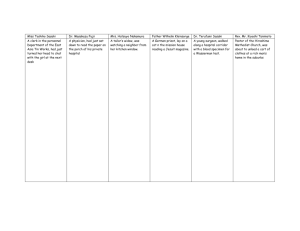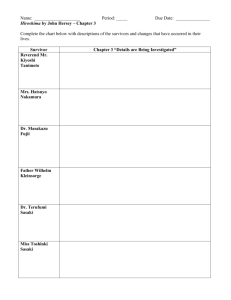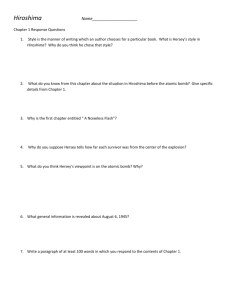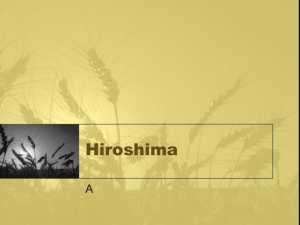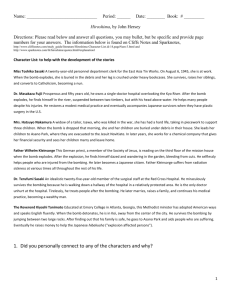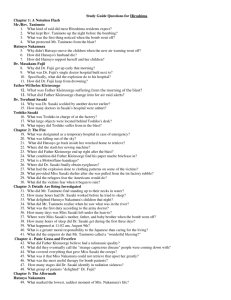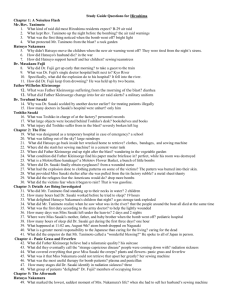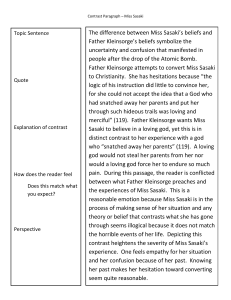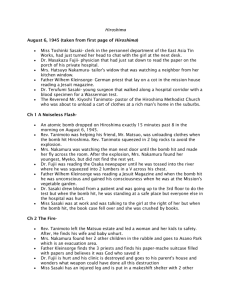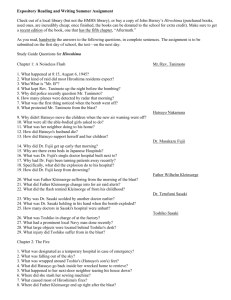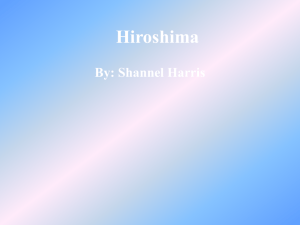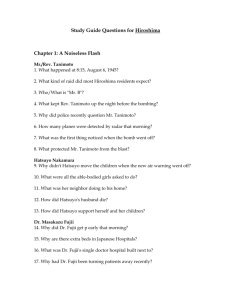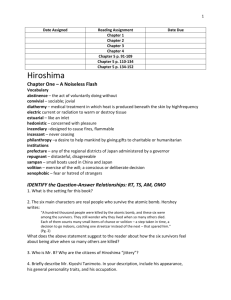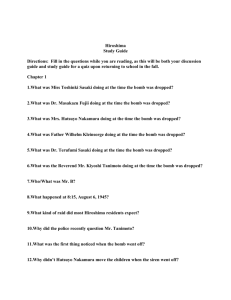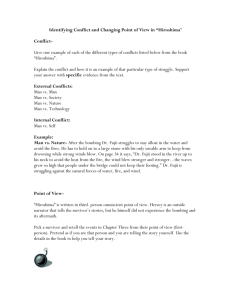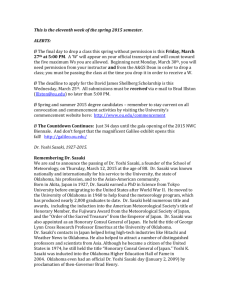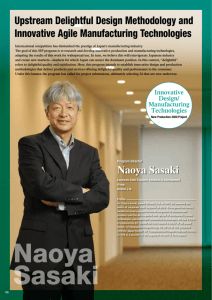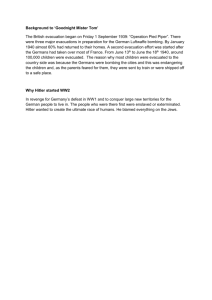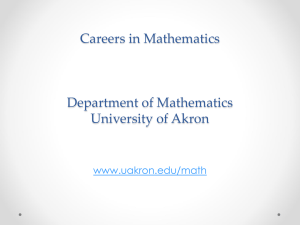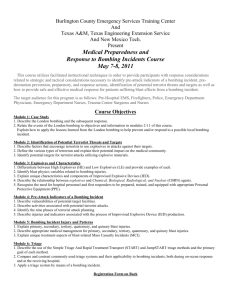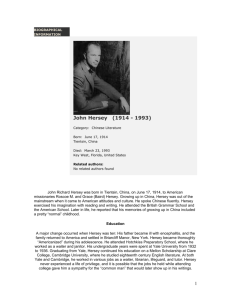the impact of narrative in literary journalism as seen through john
advertisement
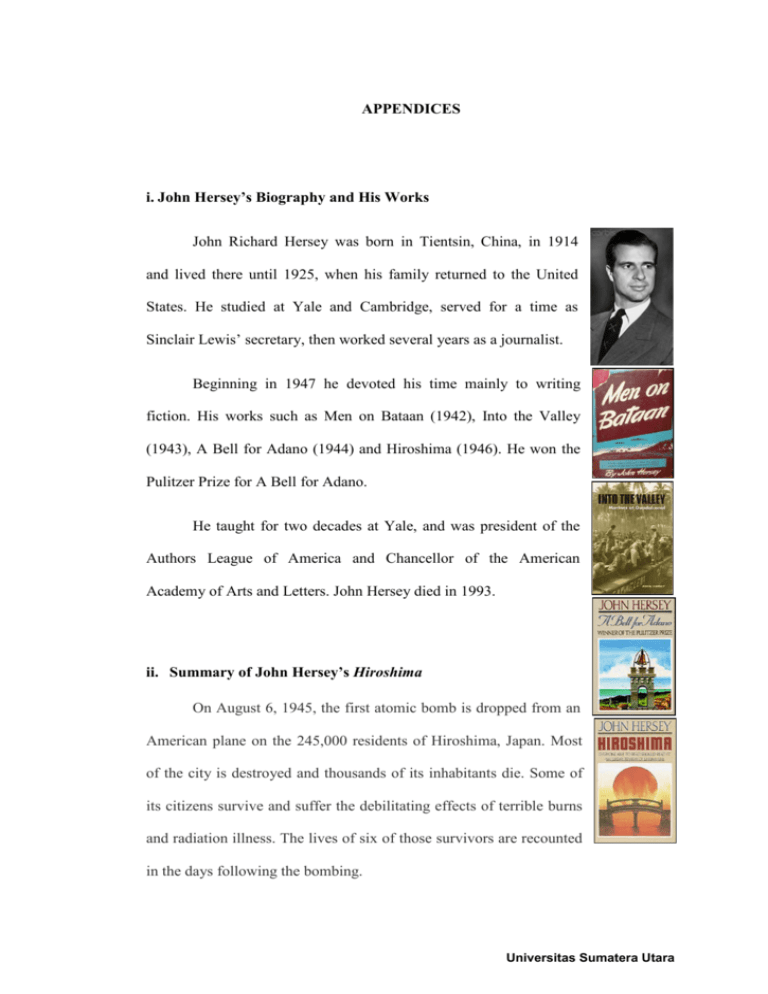
APPENDICES i. John Hersey’s Biography and His Works John Richard Hersey was born in Tientsin, China, in 1914 and lived there until 1925, when his family returned to the United States. He studied at Yale and Cambridge, served for a time as Sinclair Lewis’ secretary, then worked several years as a journalist. Beginning in 1947 he devoted his time mainly to writing fiction. His works such as Men on Bataan (1942), Into the Valley (1943), A Bell for Adano (1944) and Hiroshima (1946). He won the Pulitzer Prize for A Bell for Adano. He taught for two decades at Yale, and was president of the Authors League of America and Chancellor of the American Academy of Arts and Letters. John Hersey died in 1993. ii. Summary of John Hersey’s Hiroshima On August 6, 1945, the first atomic bomb is dropped from an American plane on the 245,000 residents of Hiroshima, Japan. Most of the city is destroyed and thousands of its inhabitants die. Some of its citizens survive and suffer the debilitating effects of terrible burns and radiation illness. The lives of six of those survivors are recounted in the days following the bombing. Universitas Sumatera Utara When the bomb detonates, Mrs. Hatsuyo Nakamura is watching her neighbor's house and overseeing her sleeping children; all end up covered in debris when their house is destroyed. Miss Toshiko Sasaki, an office clerk, is leaning over to speak to a fellow worker when she is blasted out of her desk and trapped under heavy bookcases. She sustains a severely broken leg. A medical doctor, Masakazu Fujii, is reading on his porch when he is catapulted into a river and squeezed between two large timbers. Still another doctor, Terufumi Sasaki, falls to the floor in the corridor of the Red Cross Hospital and gazes in wonder at the scene outside the window. Father Wilhelm Kleinsorge awakens in the vegetable garden of the Catholic mission house, injured and dazed. The Reverend Kiyoshi Tanimoto throws himself between two large rocks and is hit with debris from a nearby house. Most of the six survivors are hurt, but they are all alive. In the hours following the bombing, each survivor attempts to free himself or herself, find loved ones, and help others if possible. Dr. Sasaki grabs bandages and works 19 hours at a time, trying to bandage the 10,000 injured people making their way to his hospital. In the hours and days after the bombing, he becomes an automaton, going from one patient to another. Dr. Fujii, injured badly himself, attempts to help his nurses and find his way to his family's home where he can get first aid supplies. Mrs. Nakamura works relentlessly to uncover her three children in the debris; they appear unhurt but Universitas Sumatera Utara dazed and shaken. She takes them to Asano Park where they can find some shelter under trees. Miss Sasaki spends days and hours in the debris, but she is finally rescued although semi-conscious and in pain and left in a lean-to. Father Kleinsorge helps those trapped under houses and makes his way to Asano Park along with Mr. Tanimoto. Both ministers help people in the park put out fires and get medical help. During the evening of August 6, the survivors struggle to endure and help each other. The city is a ball of flame, and the park is filled with radiation rain and whirlwinds. The suffering of thousands of people and their wounds and burns are described repeatedly. Mr. Tanimoto must remind himself that these creatures are human beings. Relentlessly, he ferries boatloads of people upstream to get to higher ground. Several injured priests and the Nakamura family are evacuated to the Novitiate in the hills. The injured and dying are so numerous that the doctors no longer help the badly injured because they are not going to survive. Miss Sasaki is finally evacuated and begins many days and weeks of being moved from one hospital or aid station to another. As time goes by, order is slowly restored, but the overwhelming scene of misery and human suffering is a sharp counterpoint to the official news released from various governments. On August 9, a second bomb is dropped, this time on the Japanese city of Nagasaki. On August 15, the Emperor of Japan gives a radio address telling his people that Japan has surrendered. Next, the horrible revelations of radiation illness commence. Dr. Kleinsorge must go to a hospital in Tokyo. He will never again regain his energy or health. Miss Sasaki, also in a hospital, is so depressed over being crippled for the rest of her life that her doctor asks Father Kleinsorge to visit her. Dr. Sasaki spends months and Universitas Sumatera Utara years analyzing the effects of the radiation and how best to treat it; he marries and begins a medical practice. Dr. Fujii also opens a medical practice and begins socializing with the occupation officers. Mrs. Nakamura and her children lose their hair and suffer from various illnesses, but because they are so poor, they cannot afford to see a doctor. Mr. Tanimoto attempts to operate his church out of his badly destroyed home. The survivors struggle on with the effects of the radiation, and attempt to find ways to manage despite their injuries. A fifth chapter, "The Aftermath," was added later, detailing the lives of the survivors after the bombing (up to 1985). Mrs. Nakamura is receiving medical help for her many radiation illnesses and staying away from political rallies by the survivors, who are now called "hibakusha." The hibakusha have become the targets of politics and the peace movement. Mrs. Nakamura's children are grown, and she has retired from a job at a chemical company. Dr. Sasaki ran a lucrative medical practice. He lost his wife to cancer, and he is still haunted by the souls of those who died as a result of the bombing. Father Kleinsorge spent many years ill, both in and out of the hospital. In 1976, he slipped and fell on ice, resulting in fractures that left him bedridden. The following year he weakened, became comatose, and died. Miss Sasaki endured numerous surgeries on her leg. She converted to Catholicism and became a nun, helping people die in peace. Dr. Fujii died of cancer, but his life after the bombing was one of wealth and the pursuit of pleasure. The Reverend Mr. Tanimoto, after traveling to America several times to raise money to aid the hibakusha, has retired quietly, living out the rest of his life with vague memories that day forty years ago. Universitas Sumatera Utara
